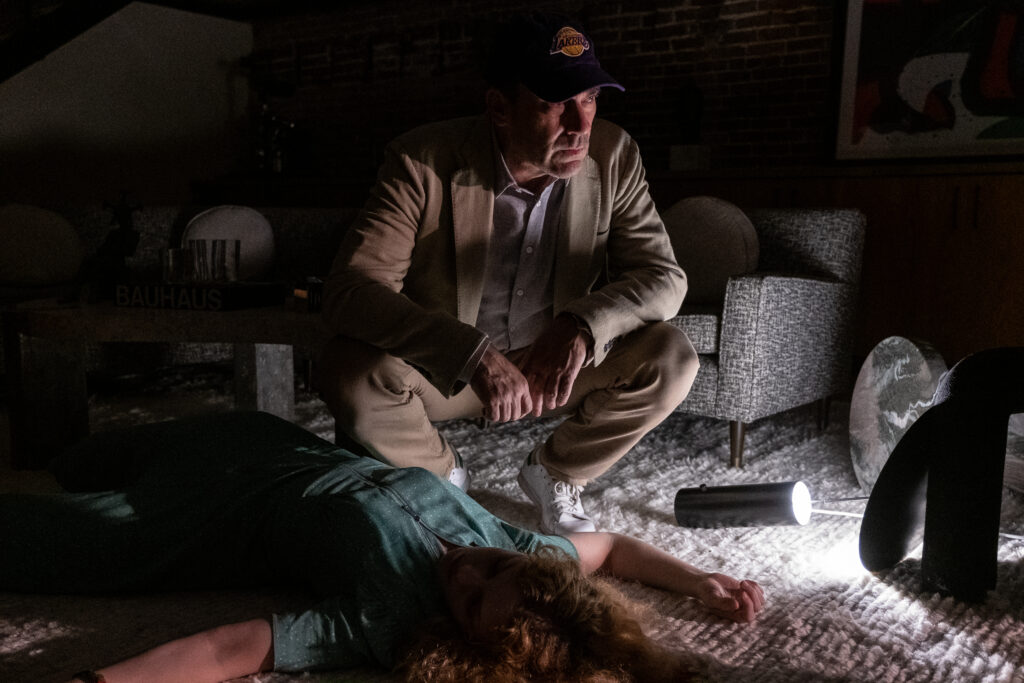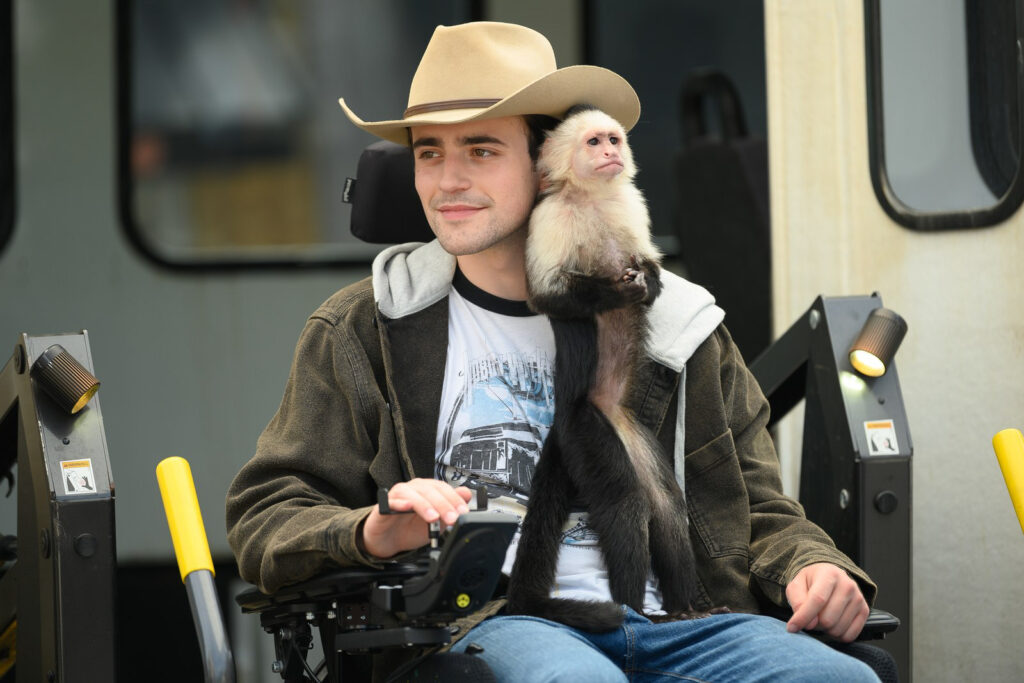March 27, 2024
by Carla Hay

Directed by Michael Keaton
Culture Representation: Taking place primarily in the Los Angeles area, the dramatic film “Knox Goes Away” features a predominantly white group of people (with some African American, Asians and Latinos) representing the working-class, middle-class and criminal underground.
Culture Clash: An assassin with dementia agrees to help his estranged adult son, who has murdered a man and wants to cover up the crime.
Culture Audience: “Knox Goes Away” will appeal primarily to people who are fans of the movie’s headliners and noir crime dramas, even if the movie has several plot holes and unanswered questions.

“Knox Goes Away” has the benefit of director/star Michael Keaton’s acting talent, but this movie about an assassin with dementia is dragged down by an uneven tone and a nonsensically convoluted screenplay with plot holes. Al Pacino has a completely useless and unnecessary role in the film. Any movie that wastes Pacino’s talent has got a lot of problems.
Directed by Keaton and written by Gregory Poirier, “Knox Goes Away” (which takes place mostly in the Los Angeles area, where the movie was filmed) tells the story of assassin John Knox (played by Keaton), who finds out early on in the story that he has Creutzfeldt-Jakob disease, which is a form of dementia. It’s a neurological disease that progresses quicker than Alzheimer’s disease. John is so paranoid about people finding out about his recent health issues, he travels by plane to San Francisco, where he meets with a medical professional named Dr. Burns (played by Paul Perri), who informs John that John has Creutzfeldt-Jakob disease. After getting this diagnosis, John is told that it will be only a matter of weeks before he loses his “normal” memory and cognitive abilities.
John (who is divorced and lives alone) is a hardened hit man who was planning to retire anyway. He now has to make arrangements to stay in an assisted living facility, since he has no family members who can take care of him. He keeps this diagnosis a secret from almost everyone he knows. For the people he does not want to tell, John says that he plans to “go away for a while.” John works for a mysterious boss named Jericho, who is never seen or heard in the movie, but Jericho’s name is mentioned several times. John agrees to do “one last job” before he retires, but he does not want to tell Jericho about this planned retirement.
It’s never stated how many years John has been a hit man, but it’s been long enough that it’s implied that it ruined John’s marriage to his ex-wife Ruby Knox (played by Marcia Gay Harden) and led to years of estrangement from their son Miles Knox (played by James Marsden), who both know about John’s past criminal activities and are aware that he’s still an assassin. John is the type of assassin who does not want to know any personal details about his targets. He frequently works with another assassin named Thomas “Tommy” Muncie (played by Ray McKinnon), who is judgmental about John’s cold detachment from their job. It’s an oddly self-righteous attitude for Thomas to have, considering that Thomas commits brutal murders for money too.
John’s “one last job” turns into a disaster. John and Thomas go to the home of their intended target: a man named Elian Zubiri (played by Edwin Garcia II), whom the assassins expect to be home alone. Thomas and John are surprised to see Elian taking a shower with a female companion, later identified as Annette Elmora (played by Nicole Reddinger), an innocent bystander who gets murdered along with Elian.
Because of John’s diminished cognitive abilites, he accidentally shoots and kills Thomas. John stages the crime scene to make the murders of Elian and Annette look like a murder-suicide committed by Elian. John then flees the scene and takes Thomas’ body with him. John later lies to Jericho by saying that Thomas never showed up for this hit job.
Shortly after that fiasco, Miles shows up unannounced at John’s home one night to confess that he has recently murdered a 32-year-old man named Andrew Palmer (played by Charles Bisset), who impregnated Miles’ 16-year-old daughter Kaylee (played by Morgan Bastin) in a sexual predator situation. Miles has a hand injury from this murder, which was committed by stabbing with a kitchen knife. Miles’ wife Cheryl Knox (played by Lela Loren) doesn’t know about this murder, and neither does anyone else at this point. What follows is a ridiculous plan that didn’t have to be as complex as it is in the movie.
Pacino has the role of John’s shady criminal friend named Xavier Crane, who is one of the few people who knows about John’s dementia. Xavier agrees to help John with a crime cover-up, but this character actually didn’t need to be in the movie at all, if John really wanted to keep his cover-up activities as secret as possible. Pacino just sort of shuffles along and mumbles in the drab and uninteresting role of Xavier.
The only other person who is close to John is a sex worker named Annie (played by Joanna Kulig), who has been meeting up with John for sessions at his home, every Tuesday for nearly four years. John is an avid book reader/collector, so he often lends books to Annie so that she can read them and tell him what she thinks about the books. It’s later mentioned in the movie that when John was in the U.S. Army, his Army buddies gave him the nickname Aristotle, because John is so intellectual and well-read. Annie and John are not in love, but they are fond of each other and have some emotional intimacy.
The “noir” tone of “Knox Goes Away” is often clumsily handled when it tries to inject some comedy, in order to make the investigating homicide police officers look idiotic. The lead investigator is Detective Emily Ikari (played by Suzy Nakamura), a jaded and sarcastic cop who always thinks she’s the smartest person in the room and spews some awkward jokes as a way to assert her authority. Nakamura is a scene stealer and has very good comedic timing, but the context in which she says these jokes are often unrealistic and cringeworthy.
For example, there’s a scene where Detective Ikari and some other cops are at the scene of a murder at the murder victim’s home. The murder victim’s body is still there. A crime scene investigation technician (played by Benita Krista Hall) tells Detective Ikari that the victim’s cell phone is locked and can only be unlocked by using facial recognition. Detective Ikari then makes a snide remark by telling the technician to do the obvious: Put the phone up to the victim’s face to unlock the phone. Making this technician look this stupid is the movie’s cheap and lazy setup to have Detective Ikari crack another “joke,” usually at the expense of a subordinate or co-worker.
“Knox Goes Away” also doesn’t do much to explain why John became an assassin. The main things that are revealed about John’s past are that he has a troubled history as a father; he used to be a deep reconnaissance officer in the U.S. Army; and he spent six years in prison for tax evasion. John is supposed to be highly intelligent (he has doctorate degrees in English literature and U.S. history), but he makes a lot of illogical decisions—and not just because of his dementia. It’s because of a weak screenplay that tries to look like it’s clever, but it’s really a long-winded excuse to show some mindless and muddled scheming that leads to a predictable ending.
Saban Films released “Knox Goes Away” in select U.S. cinemas on March 15, 2024. The movie will be released on digital and VOD on April 5, 2024.




